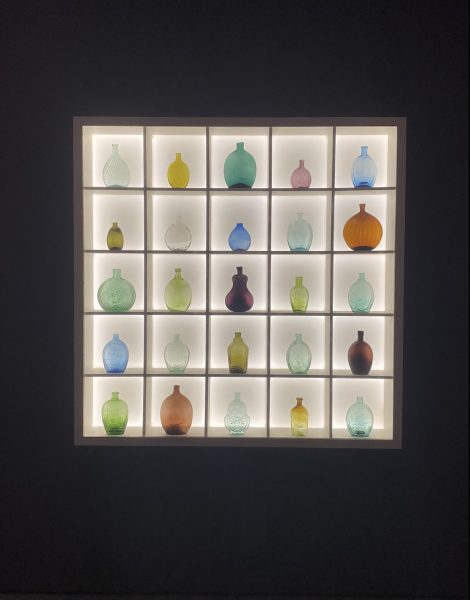
The New Orleans Museum of Art’s new special exhibition, “Sand, Ash, Heat: Glass at the New Orleans Museum of Art,” wants to wow you. With pieces exclusively from the museum’s permanent collections, this exhibit highlights glasswork throughout history and examines its social, economic and scientific impact.
As soon as you enter, you are confronted by a magnificent black glass chandelier. The piece, titled “The Way the Moon’s in Love with the Dark” by artist Fred Wilson, hangs alone at the entrance to the exhibit. Taking influence from both Venetian and Persian glasswork, Wilson expertly uses glass to confront the erasure of black influence in European art history. Though full of wonder and beauty, this glass giant questions the single-sided narrative of traditional art history. This piece is just the first of many thought-provoking glass artworks in the exhibit and it embodies the main theme of NOMA’s exhibit: beauty and tension in glass.
Moving through this exhibit, you view the development of glass working throughout history. An apt introduction to the exhibit, the section next to the entrance showcases glasswork pieces that span all human history. From a crystalline Chinese vase to a bright pink wig stand, you are given just a small taste of the versatility of glass as an artistic material.
Next is a small gallery that highlights the birthplace of man-made glass creations — Egypt — and the trade networks that allowed it to spread. Here you can view various small glass vessels from the Syro-Palestinian Coast to the Roman Empire. This beautiful spread shows the beginnings of glassblowing techniques — originating around Jerusalem — and how ancient cultures created their own unique styles.
Moving on, you learn about the history of the glass in Venice, whose main production was isolated to the island of Murano in 1292. Since then, Venice has been at the forefront of innovative glass techniques. The pieces to be seen here include wonderfully delicate glasses with thin, decorative handles and white stripes embedded in their walls.
The next section highlights glass in Northern and Central Europe with large drinking glasses depicting the faces of kings. It also includes a fascinatingly scientific aspect — conservation. The exhibit labels explain the chemistry of glass and how it ages and degrades, altering the look of the piece. In a nearby case, you can clearly see where the acidity of the soil has discolored one piece. In others, you can see the effects of excess manganese on the atomic bonds and clear evidence of imperfect restoration.

While all American art can never escape politicization, American glass seems to openly discuss it more than one might expect. In the American glass section, a beautifully backlit display of liquor flasks shows the United States’ growing economic and political world. Many of these vessels express loyalty to presidents or support for economic reforms. Three unassuming pieces sit on pedestals along the back wall of this section. Upon closer inspection, however, each pedestal is decorated with pictures of the foodstuff they were created to hold — bananas, sugar and celery. The exhibit uses these to examine American cuisine’s relationship with trade, elitism and forced labor. Still more American glass displays New Orleans landmarks, abolitionist movements and imperialistic propaganda.
The rest of the exhibit homes in on what the panels call “art for art’s sake,” which — for glass — started in the nineteenth century. Technological advancements and modern ideals shape the pieces in this section. A particularly interesting one, made by American designer Walter Dorwin Teague, merges technology and fine art by using the mold from a factory for a locomotive headlight lens to create an industrial-looking bowl.
The exhibit also features a section on glass beading in African and Indigenous American mediums in a conversation around a magnificent New Orleans Black Masking “Mardi Gras Indians” beaded suit.
The end of the exhibit features many Louisiana and Tulane University glass artists. Deborah Czeresko — a participant in Tulane’s glass program in the 1990s — has three large works near the exit that explore male-dominated artistic spaces and femininity. The founder of Tulane’s glass program, Gene Koss, is featured and credited as a contributor. His sculpture Fence Row emphasizes the manual labor that goes into glasswork and his smaller Ridge Road Climb attempts to elevate glass to the realm of fine art. Other Louisiana artists featured include Newcomb College trained Lynda Benglis of Lake Charles as well as Dawn DeDeaux and Mitchell Gaudet, both of New Orleans.
This exhibit beautifully merges art history, technology, science, foodways and economy in a jaw-dropping collection of pieces. It continues through the NOMA’s sculpture garden — which I recommend visiting as it enhances your art viewing experience through more glass artworks sprinkled throughout the permanent collection. “Sand, Ash, Heat” is a riveting experience that pulls you through history in new ways that I never would have connected to glasswork before.



